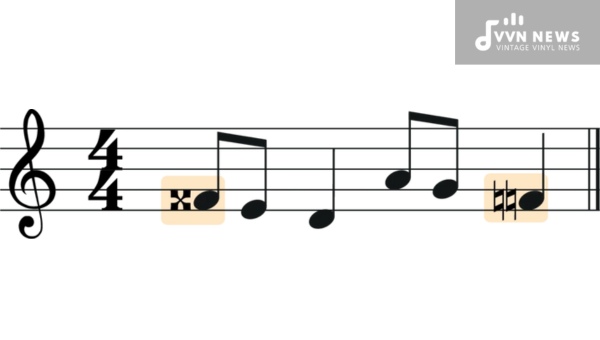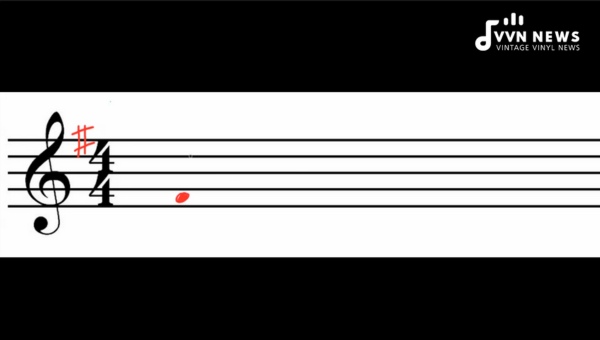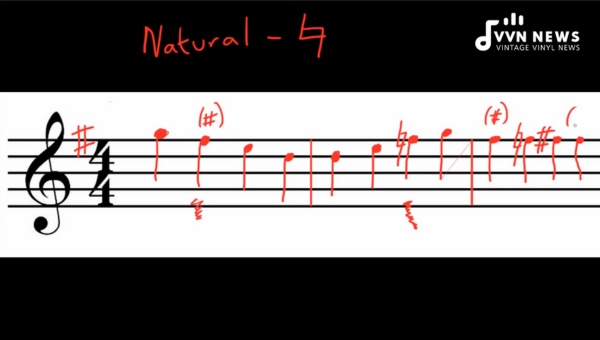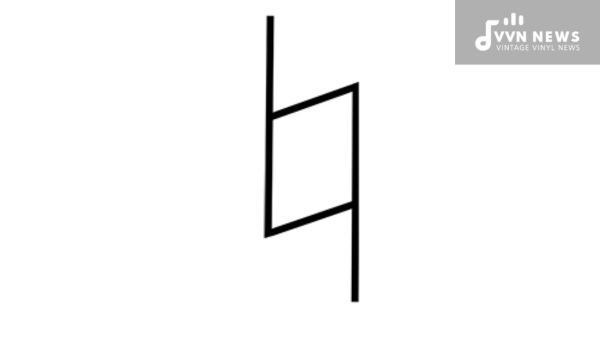Navigating the world of music theory might seem daunting at first with its various symbols and notations, but understanding them is akin to finding the keys to a secret garden.
One such symbol that holds significant importance is the natural sign in music.
It’s a simple yet pivotal part of reading and writing music, serving as both a navigational tool and an anchor within the diverse landscape of melodies and harmonies.
It’s intriguing to think about how a single sign can alter the pitch of a note and essentially change the mood or direction of a piece.
The natural sign acts as a reset button, allowing notes to return to their original state after being modified by sharps or flats.
This capability makes it an essential element for musicians, composers, and anyone keen to comprehend the structure behind musical scores.
What is a Natural Sign in Music?
A natural sign, denoted by the symbol ♮, is an essential notation in sheet music.
It instructs the musician to play a previously altered note—whether sharp or flat—at its original pitch.
For instance, if a note has been marked with a sharp (♯), making it one semitone higher, placing a ♮ before the same note line or space within a measure cancels out the sharp. It’s as if it tells the note to “come home” to its unaltered state.
Encountering this sign indicates a specific, intentional switching back to the standard pitch of that note, thus serving as an important guidepost for performers navigating their way through dynamic compositions.
How Do You Draw a Natural Sign in Music?

Drawing a natural sign is simple once you’re acquainted with its structure. Start by drawing an upright line that extends from the bottom line to the top line of the staff.
Next, at the top of this line, create a small left-facing hook. Then, from the same starting point but just below the middle staff line, draw another short diagonal line slanting downward to the right.
Imagine you’re sketching two tiny square ticks facing opposite directions; one juts up and left while the other goes down and right.
These ticks should intersect slightly with your central vertical stroke. Essentially, the natural sign looks like a slightly asymmetrical lowercase “n.”
To ensure clarity in your music notation:
- Keep your lines thin and evenly spaced.
- Place the symbol directly in front of the affected note.
- Align it such that it centers around the modified pitch’s staff line or space.
Your natural sign must be distinctly visible to prevent any confusion about a note’s pitch, thus maintaining the seamless flow of your musical narrative.
Also Read: F Music Note [Unlock The Secrets Of The Musical Alphabet]
What Role Does a Natural Sign Play in Music?
The natural sign is a core component of written music, influencing how pieces are interpreted and played. Here’s how it functions:
- Resets Altered Notes: It counteracts the effect of sharps (♯) and flats (♭), bringing them back to their original pitch.
- Prevents Confusion: With multiple accidentals in a score, it clarifies note pitches, ensuring musicians perform each note correctly without second-guessing.
- Facilitates Key Changes: When a piece shifts key signatures midstream, natural signs help signal the transition clearly.
- Modifies Chords: It’s instrumental in building chords correctly, particularly when switching between major and minor or diminished and augmented types within a piece.
- Enhances Melodic Expression: By allowing quick alternation between altered and non-altered notes, it offers expanded expressive capabilities.
By deploying the natural sign aptly, composers exert precise control over their musical vision, guaranteeing that performers can deliver the intended auditory experience.
What Are the Basic Rules for Using Natural Signs?

When it comes to incorporating natural signs into musical notation, adhere to these key principles:
- Placement: Place the natural sign directly in front of the note that it is meant to modify on the same line or space of the staff.
- Scope: A natural sign affects all notes of the same pitch within the same measure, overriding any sharps or flats from the key signature or accidentals previously marked.
- Order: If a measure contains multiple accidentals (including naturals), they should be read from left to right in sequence, as they appear.
- Bar Lines: Once you cross a bar line, the effect of the natural sign is cancelled unless it’s reiterated in subsequent measures.
By keeping these core guidelines in mind, interpreting and applying natural signs becomes a streamlined process that enhances your ability to read and perform music.
Also Read: Mixolydian Mode [Add Depth & Richness To Your Music Today]
What Is a Double Natural Sign and When Is It Used?
In music notation, the double natural sign is an intriguing character that occasionally graces the score.
While a single natural sign cancels previous sharps or flats on a specific note, its less frequent cousin – the double natural sign – takes this reset one step further.
The double natural is rare because it specifically addresses notes that have been doubly altered – for instance, if a note has been notated with a double sharp (x) or a double flat (????).
The purpose of the double natural (♮♮) is to revert these notes back to their unaltered pitch; it essentially tells the musician to ignore both alterations and play the note as if it were in its “natural” or basic form without any sharps or flats.
Here are some key points about when this symbol might make an appearance:
- Occurrence in Complex Scores: You’re more likely to encounter it within complicated classical compositions or pieces with heavy chromaticism.
- Transitional Phases: It can also be found during modulations, where music shifts from one key to another, necessitating various adjustments to pitch.
- Unconventional Harmonies: Modern or experimental music may use it as composers push boundaries with unconventional tuning systems.
The double natural sign underscores music’s intricate structure; it ensures precision in the pitches that performers produce, maintaining the integrity of the theoretical framework established by composers.
Though its application might not be as commonplace as other musical symbols, it plays an essential part in conveying complex musical ideas clearly.
Also Read: Aeolian Mode [The Secret To Creating Moody & Expressive Music]
How Does a Natural Sign Affect Musical Notes?

In the tapestry of musical notation, the natural sign holds a power that both supplements and nullifies.
Let’s unravel how this symbol impacts the notes it graces:
- Returning to the Original Pitch: A natural sign cancels any previous accidentals (sharps and flats) applied to a note, effectively bringing it back to its original pitch.
- Resetting Within a Measure: Within a given measure, if a sharp or flat is introduced, a natural sign later in the same measure ensures that any subsequent appearances of that note are played at their natural pitch.
- Scope Beyond One Measure: Unless carrying through via a tie, naturals don’t typically extend their influence beyond the measure they’re in; each new measure is considered a clean slate unless otherwise indicated.
- No Effect On Unaltered Notes: If a note hasn’t been modified by an accidental earlier in the piece or within the same measure, placing a natural sign has no effect as it’s already at its natural state.
- Enharmonic Equivalence Clarification: Sometimes, composers use natural signs to clarify enharmonic equivalence — for instance indicating that what could be played as an F sharp should instead be played as a G flat for harmonic or melodic reasons.
To encapsulate how this works:
- A C# followed by another C within the same bar would need a natural sign to denote that the second C is no longer sharp.
- The appearance of Db in one bar will not require D♮ (D natural) in the next bar unless Db reappears and D♮ is needed in contrast.
The effective range of this unassuming symbol is limited to direct interactions with modified notes. Remember:
- Sharp raises pitch—natural lowers it back down
- Flat lowers pitch—natural brings it back up
The understanding of music’s intricate notation system ensures performer precision and facilitates emotive interpretations, where adhering to every flick of pen on score meticulously crafts auditory landscapes peppered with nuance.
The Role of the Natural Sign in Various Musical Genres
The natural sign is a versatile and indispensable part of musical notation, cutting across a wide spectrum of genres with its unique function.
Its application remains consistent—altering notes that have previously been sharpened or flattened back to their original pitches—but its impact can be as varied as the genres themselves.
Here’s how this notational symbol plays out across different types of music:
Classical Music
- Reverting to Original Pitch: In the highly structured compositions found in classical music, where precision is paramount, the natural sign is crucial for indicating when a note should be played in its pure form after previous alterations.
- Complex Harmonies: Given the intricate harmonies often present in this genre, naturals are essential for maintaining the intended harmonic structure.
Jazz
- Improvisation: As jazz musicians often improvise, they rely on the natural sign to guide them back to a standard scale from an altered note.
- Blues Scale: In the blues scale, which underpins much of jazz harmony, naturals may revert certain notes that could disrupt the characteristic ‘blues’ sound.
Also Read: D Major: The Scales And Chords [Broaden Your Musical Vocabulary]
Rock and Pop
- Chord Progressions: Naturals play an important role in rock and pop melodies by ensuring that chord progressions run smoothly and without unintended dissonance.
- Transposition Ease: For flexible transposition between keys—a common occurrence in these genres—natural signs help musicians change pitch references quickly.
Folk Music
- Modal Variations: Many folk music systems use modes rather than scales as their foundation, with naturals used to signal shifts between these modes within pieces.
Electronic Music
- Notation Reference: Though electronic music typically deals with synthesized sounds, natural signs can still appear as references within software-based notation helping guide electronic musicians during composition or collaboration.
By grasping the function of the natural sign across these diverse musical landscapes, one appreciates how this simple notation keeps compositions coherent and expressive no matter what stylistic path they tread.
Also Read: G Major Scales And Chords [Expand Your Musical Understandings]
FAQs about the Natural Sign-in Music
What exactly does the natural sign indicate for a musician?
The natural sign tells a musician to play the note as it naturally occurs in the scale, without any sharp or flat alterations.
Is a natural sign only used after a sharp or flat has been introduced?
Yes, a natural sign typically cancels a previous sharp or flat and is only necessary after an accidental has been applied.
Can a natural sign apply to all octaves of a note?
No, a natural sign affects only the octave in which it appears unless indicated by the score (such as through the use of key signatures).
How frequently can you encounter natural signs in sheet music?
You’ll see natural signs quite often, especially in pieces that modulate between keys or use many accidentals.
In music notation programs, how do I insert a natural sign?
Most music notation programs have a palette of musical symbols where you can select and insert natural signs into your score with just a click.
Conclusion
The natural sign plays a crucial role in music composition and interpretation.
It is your guide to returning altered notes back to their original pitches, ensuring harmony and integrity within a piece.
Whenever you encounter a sharp or flat, the natural sign informs you it’s time to reset.
The application reaches across genres, making it versatile and universal in the music world.
Embrace this symbol as your ally on the musical staff, for it is an essential ingredient in the recipe for melodic clarity and expression.








